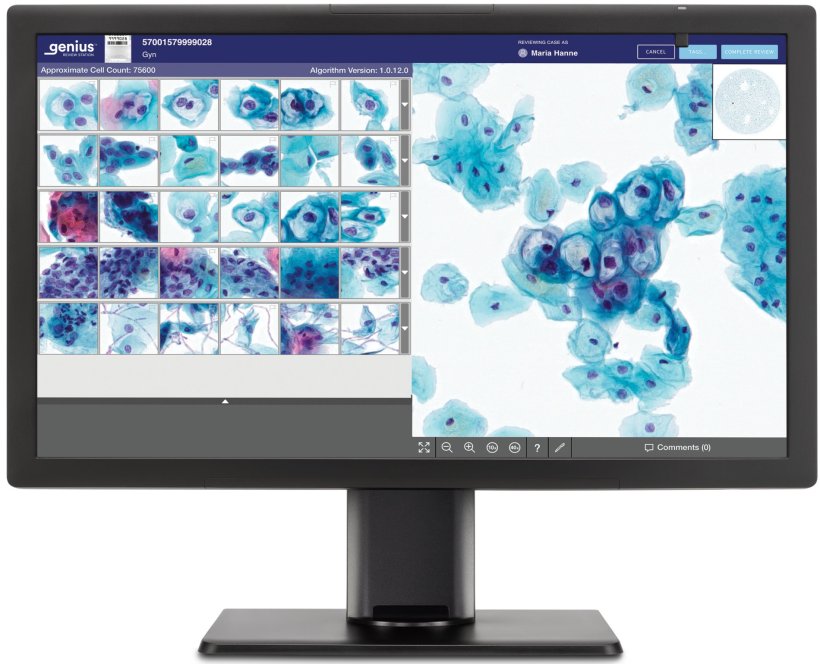Image source: Hologic
Article • Addressing diagnostic backlogs
Harnessing the power of AI for women's health
Author: Craig Howes, Hologic Senior Director of Marketing, Breast and Skeletal Health, International

Image source: Hologic
Although the Covid-19 pandemic is behind us, healthcare facilities continue to experience workflow challenges and resource constraints impacting women’s health and a patient’s ability to receive a timely diagnosis. Clinical specialties like breast radiology and cytology are especially susceptible to these issues and continue to experience backlogs, which impact their ability to deliver timely diagnosis and treatment.
Solutions leveraging artificial intelligence (AI) can help facilities address this crisis in women’s health. These innovative healthcare solutions have been gaining momentum for over a decade offering a promising path forward in improving women's outcomes worldwide.
As AI technology continues to evolve, its ability to help to improve detection, address backlogs, and improve workflows, along with its potential to increase access to preventative care for patients, could play a crucial role in advancing women’s health.
Addressing resource constraints
Resource and time constraints pose challenges for breast and cervical cancer screening programmes across Europe. Shortages of radiologists and cytologists prompt clinics and hospitals to explore ways to streamline processes, with AI and innovative diagnostic technology offering promising solutions.

Image source: Hologic
The European Council’s recent recommendation that digital breast tomosynthesis (DBT) be adopted for breast cancer screening means that radiologists have more images to review. However, AI tools such as Hologic's 3DQuorum Imaging Technology can assist them by reducing the number of images they need to review, as it creates high-resolution, overlapping "SmartSlices" to expedite reading time. This technology reconstructs high-resolution DBT data to produce 6mm overlapping image slices that do not compromise image quality, sensitivity or accuracy.1,2 When a radiologist reads SmartSlices instead of 1mm slices, the number of DBT images to review is reduced by two-thirds3-5, leading to an average interpretation time savings of one hour per day.6
Traditionally, routine breast screening images require a second reader for accuracy, which can be a burden for radiologists as it increases the time it takes to review. AI has the potential to replace this second reader as the solution can complement radiologists' expertise by efficiently locating areas of interest within mammograms. By expediting the review process, AI can assist in streamlining image analysis, allowing radiologists to work quickly and effectively.
Recommended article

Article • Technology overview
Artificial intelligence (AI) in healthcare
With the help of artificial intelligence, computers are to simulate human thought processes. Machine learning is intended to support almost all medical specialties. But what is going on inside an AI algorithm, what are its decisions based on? Can you even entrust a medical diagnosis to a machine? Clarifying these questions remains a central aspect of AI research and development.
Next-generation AI solutions, like Hologic’s Genius AI Detection, are designed to identify suspicious areas in mammograms. These deep learning AI based solutions have significantly reduced false-positive markings compared to previous generation CAD solutions while offering increased detection.7 In addition, research shows that these next-gen algorithms have an exceptional ability to correctly match pairs of Regions of Interest (ROIs) in different views,8 which illustrates how AI technology can supplement radiologist workflow. These advancements underscore the transformative potential of AI in enhancing breast cancer screening efficiency.
Cervical cancer screening exhibits similar challenges, including backlogs, resource limitations, and more. Globally, cervical cancer is the fourth most common cancer in women, with around 660,000 new cases and 350,000 deaths in 2022.9 When diagnosed, cervical cancer is one of the most successfully treatable forms of cancer, provided it is detected early and managed effectively.10

Image source: Hologic
Screenings for cervical cancer begins when a sample is collected at a doctor's office, and the cervical cells are sent to a lab where they are transferred to a glass slide. To date, this glass slide has typically been reviewed under a microscope. With Hologic’s newest innovation, the Genius Digital Diagnostics System11, the glass slides are digitally imaged, and an AI algorithm is applied to pinpoint the cells that cytologists and pathologists should review. The platform is the first CE-marked digital cytology system to combine a new AI algorithm with advanced volumetric imaging technology, and it recently became the first and only FDA cleared digital cytology system in the United States. This new technology offers promising opportunities to enhance workflows and enable greater collaboration across lab and other healthcare settings.
Digital imaging technology enables cytologists and pathologists to review cases locally, or remotely across a lab network, which ultimately aims to reduce costs and wait time and optimizes available resources. Genius Digital Diagnostics is the next step forward in cervical cancer screening, empowering labs with new AI-based technology to help eradicate cervical cancer.
Pioneering AI in women’s health
It’s clear that AI can help improve cancer detection, operational efficiency, and clinical decision support. As the technology continues to advance, AI will enable more personalization and inclusivity to ensure that more women can benefit from these advancements. Already, we are witnessing efforts to leverage these technologies to reduce healthcare disparities, as AI has the potential to bridge gaps in expertise by supporting less experienced radiologists or cytologists in their decision making. This is particularly crucial in areas of the world that lack access to specialists, where AI tools may help reduce interpretation variations for more generalized healthcare providers.
The latest solutions for breast and cervical cancer screenings help patients with urgent needs receive timely diagnosis, enhancing their overall care experience
Craig Howes
Advancements in digitalization and remote reading suggest a future where healthcare facilities in remote or underserved areas can access high-quality imaging and diagnostic services without logistical barriers. Additionally, for women who travel long distances for screenings, AI can aid in triaging. Previously, radiologists would have to pause reading to promptly review results for those patients traveling distances, but AI tools can now flag areas of concern in real-time, allowing prioritization of complex cases. The latest solutions for breast and cervical cancer screenings help patients with urgent needs receive timely diagnosis, enhancing their overall care experience.
The prevalence of AI in healthcare will only continue to grow in the coming years. An ongoing commitment to innovation should undoubtedly include leveraging these algorithms, especially in pioneering advancements in women’s health. The technologies available today are already helping to address some of the existing backlogs in breast and cervical cancer screenings, and to increase access to innovations that aid in early detection. Companies leading this movement must continuously refine their technology to enhance patient care, prioritizing inclusivity and accessibility so that women—no matter where they live—can benefit from these advancements.
References:
- Hologic data on file: DHM-08611 Rev. 006
- Clinical Study Report CSR-00116 Rev. 004
- Data on File: TFL-00059 2/3 Rev. 042
- MAN-06153 Rev. 002 Dimensions Breast Tomo
- MAN-06029-002 Rev.004 3DQuorum
- Data on File: Clinical Study Report CSR-00116 Rev. 004
- Kshirsagar A. Comparison between ImageChecker CAD and GAID algorithm on sequestered FDA database. 2023. Refer to Hologic document (DHM-14593)
- Friedewald SM, Dsouza A, Phargi C, et al. Correlating breast lesions in tomosynthesis CC and MLO views using artificial intelligence (AI). Accepted as podium presentation at ECR 2024. Last accessed 22 May 24
- World Health Organization. Cervical cancer Fact Sheet. March 2024. Last accessed 5 February 2024
- World Health Organization. Cervical cancer. Last accessed 5 February 2024
- Genius Digital Diagnostics manual: AW-24823-001 Rev 001
24.06.2024










